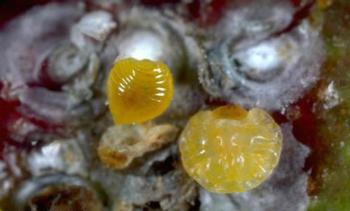San Jose scale

San Jose scales overwinter predominantly in the black cap stage, although in mild years some adult females may also survive. In late January, these nymphs resume their growth. These overwintering scales become adults during March. Immature male and female scales are indistinguishable until after the first molt when the body of the male begins to elongate. Males molt a total of four times after which yellowish, winged adult males emerge to mate with females. The adult female San Jose scale remains under its shell, which is gray and circular; the body under the shell covering is yellow. After a period of about two months, crawlers from the overwintering females begin emerging in April, with their peak emergence usually in early May. Although crawlers are present throughout the summer and fall, there are usually four generations per year.
(Description from UC Pest Management Guidelines)

